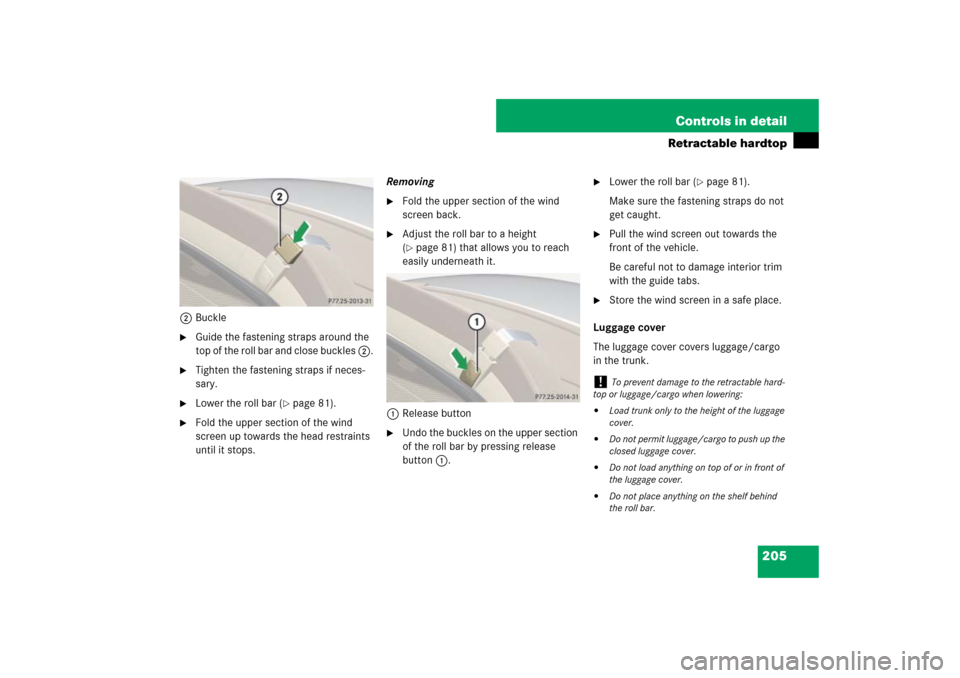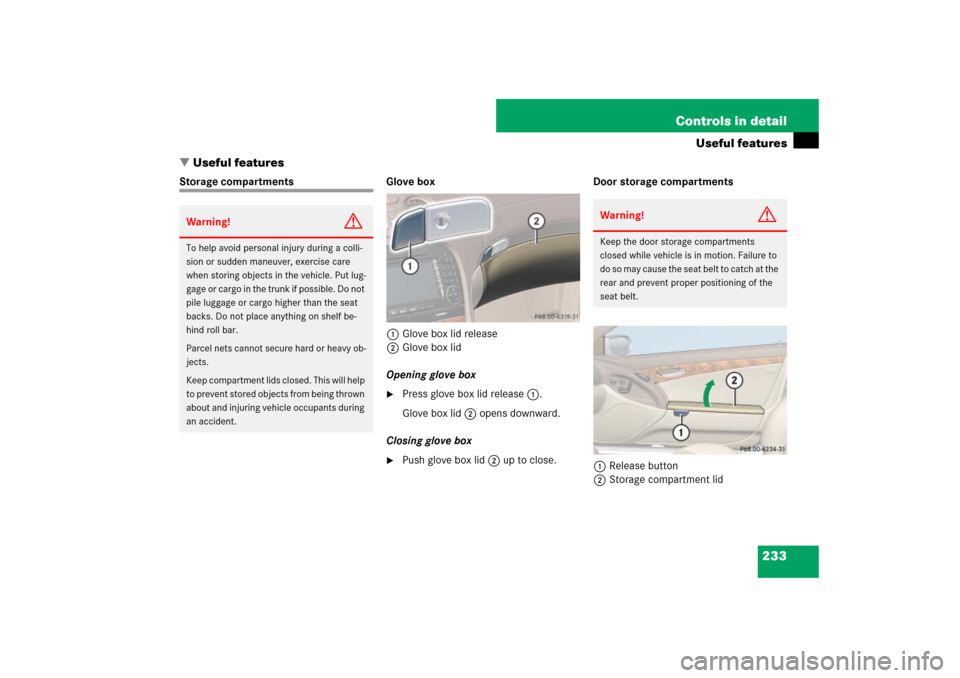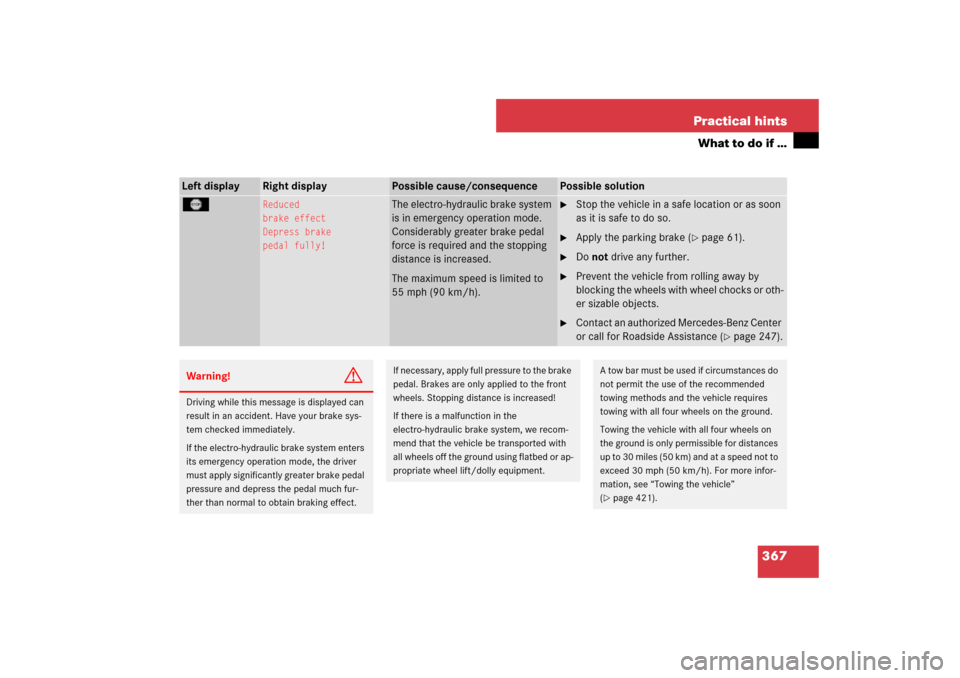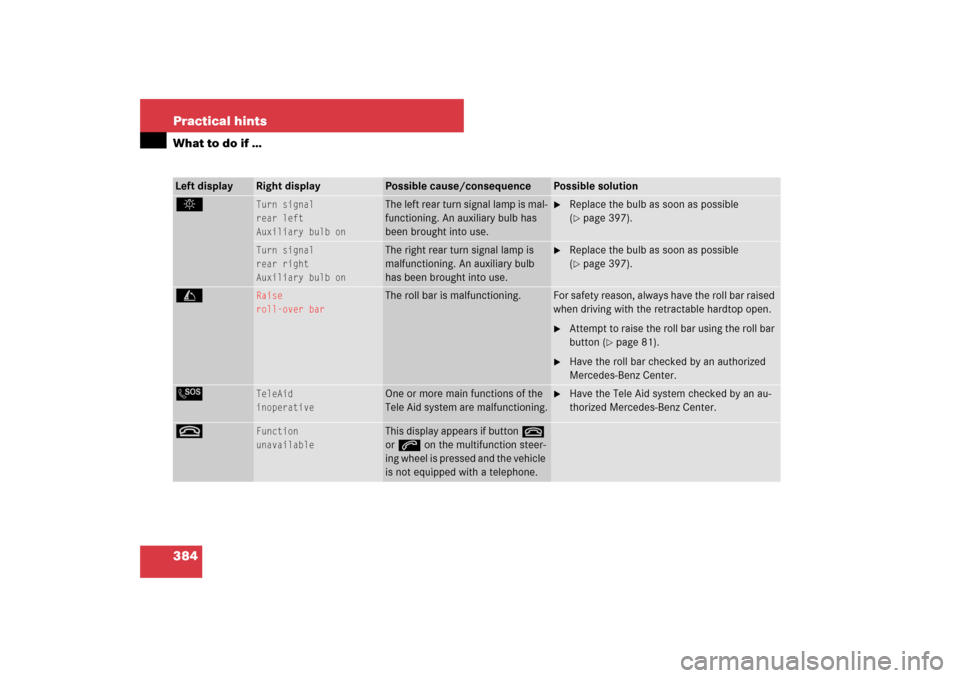Page 202 of 473

201 Controls in detail
Retractable hardtop
Retractable hardtop switch1Opening
2Closing�
Engage the parking brake (
�page 54).
�
Close the luggage cover, see “Luggage
cover” (
�page 205).
�
Close the trunk lid.
�
Switch on the ignition (
�page 39).Opening
�
Pull up on the retractable hardtop
switch as indicated by arrow 1 until
the retractable hardtop is completely
lowered into its trunk storage compart-
ment.
The multifunction display will briefly
show the message K
in operation
.
Closing
�
Press down on the retractable hardtop
switch as indicated by arrow 2 until
the retractable hardtop is completely
closed and locked.
The multifunction display will briefly
show the message K
in operation
.Opening/closing with the SmartKey
i
Make sure the retractable hardtop is dry be-
fore you open it. Otherwise water may enter the
trunk interior.
Warning!
G
Before operating the retractable hardtop,
make sure there is no danger of anyone
being injured by the moving parts (retract-
able roof, roof frame, and trunk lid) due to in-
attention.
Hands must never be placed near the roof
frame, upper windshield area, hardtop, shelf
behind roll bars, or trunk lid while the re-
tractable hardtop is being raised or lowered.
Serious personal injury may occur.
If potential danger exists, release the re-
spective button on the SmartKey. This im-
mediately interrupts the raising or lowering
procedure. You then can press button Œ
or ‹to raise or lower the hardtop away
from the danger zone.
Page 205 of 473

204 Controls in detailRetractable hardtop�
The hardtop drive system has shut it-
self down. For safety reasons, no more
than five consecutive attempts may be
made to raise or lower the hardtop.�
After about 10 minutes you may
again attempt to open or close the
retractable hardtop.
�
If the retractable hardtop still does
open, close, or lock properly, have
the retractable hardtop system
checked at an authorized
Mercedes-Benz Center.
�
There is a malfunction in the retract-
able hardtop system.�
Notify an authorized
Mercedes-Benz Center.Wind screen
The wind screen deflects drafts away from
the driver and passenger when the retract-
able hardtop is lowered. It is stored in the
trunk.
Installing
�
Leave the wind screen folded and place
it on the roll bar.1Guide tabs
�
Slide the wind screen into the roll bar
until guide taps 1 on each side latch
underneath the roll bar.
Make sure the fastening straps do not
get caught.
�
Adjust the roll bar to a height
(�page 81) that allows you to reach
easily underneath it.
Warning!
G
The wind screen can restrict the driver’s vi-
sion to the rear of the vehicle. To prevent a
possible accident when visibility is limited
(e.g. in darkness), the upper part of the wind
screen should be folded back.
Page 206 of 473

205 Controls in detail
Retractable hardtop
2Buckle�
Guide the fastening straps around the
top of the roll bar and close buckles 2.
�
Tighten the fastening straps if neces-
sary.
�
Lower the roll bar (
�page 81).
�
Fold the upper section of the wind
screen up towards the head restraints
until it stops.Removing
�
Fold the upper section of the wind
screen back.
�
Adjust the roll bar to a height
(�page 81) that allows you to reach
easily underneath it.
1Release button
�
Undo the buckles on the upper section
of the roll bar by pressing release
button1.
�
Lower the roll bar (
�page 81).
Make sure the fastening straps do not
get caught.
�
Pull the wind screen out towards the
front of the vehicle.
Be careful not to damage interior trim
with the guide tabs.
�
Store the wind screen in a safe place.
Luggage cover
The luggage cover covers luggage/cargo
in the trunk.
!
To prevent damage to the retractable hard-
top or luggage/cargo when lowering:
�
Load trunk only to the height of the luggage
cover.
�
Do not permit luggage/cargo to push up the
closed luggage cover.
�
Do not load anything on top of or in front of
the luggage cover.
�
Do not place anything on the shelf behind
the roll bar.
Page 234 of 473

233 Controls in detail
Useful features
�Useful features
Storage compartments Glove box
1Glove box lid release
2Glove box lid
Opening glove box
�
Press glove box lid release1.
Glove box lid 2 opens downward.
Closing glove box
�
Push glove box lid 2 up to close.Door storage compartments
1Release button
2Storage compartment lid
Warning!
G
To help avoid personal injury during a colli-
sion or sudden maneuver, exercise care
when storing objects in the vehicle. Put lug-
gage or cargo in the trunk if possible. Do not
pile luggage or cargo higher than the seat
backs. Do not place anything on shelf be-
hind roll bar.
Parcel nets cannot secure hard or heavy ob-
jects.
Keep compartment lids closed. This will help
to prevent stored objects from being thrown
about and injuring vehicle occupants during
an accident.
Warning!
G
Keep the door storage compartments
closed while vehicle is in motion. Failure to
do so may cause the seat belt to catch at the
rear and prevent proper positioning of the
seat belt.
Page 341 of 473
340 Practical hintsWhat to do if …Problem
Possible cause/consequence
Suggested solution
C
The yellow roll bar warning lamp
comes on or flickers when the
engine is running.
The roll bar system is malfunctioning.
For safety reasons, always have the roll
bar raised when driving with the retract-
able hardtop open.�
Attempt to raise the roll bar manually
(�page 81).
�
Have the roll bar checked by an au-
thorized Mercedes-Benz Center as
soon as possible.
Warning!
G
If the roll bar warning lamp does not come
on, does not go out after a long time, flickers
or comes on while driving as described
above, then the roll bar system is not oper-
ating properly and may not activate in an
accident. In this case, raise the roll bar man-
ually (
�page 81) before continuing to drive.
Page 368 of 473

367 Practical hints
What to do if …
Left display
Right display
Possible cause/consequence
Possible solution
T
Reduced
brake effect
Depress brake
pedal fully!
The electro-hydraulic brake system
is in emergency operation mode.
Considerably greater brake pedal
force is required and the stopping
distance is increased.
The maximum speed is limited to
55 mph (90 km/h).
�
Stop the vehicle in a safe location or as soon
as it is safe to do so.
�
Apply the parking brake (
�page 61).
�
Do not drive any further.
�
Prevent the vehicle from rolling away by
blocking the wheels with wheel chocks or oth-
er sizable objects.
�
Contact an authorized Mercedes-Benz Center
or call for Roadside Assistance (
�page 247).
Warning!
G
Driving while this message is displayed can
result in an accident. Have your brake sys-
tem checked immediately.
If the electro-hydraulic brake system enters
its emergency operation mode, the driver
must apply significantly greater brake pedal
pressure and depress the pedal much fur-
ther than normal to obtain braking effect.
If necessary, apply full pressure to the brake
pedal. Brakes are only applied to the front
wheels. Stopping distance is increased!
If there is a malfunction in the
electro-hydraulic brake system, we recom-
mend that the vehicle be transported with
all wheels off the ground using flatbed or ap-
propriate wheel lift/dolly equipment.
A tow bar must be used if circumstances do
not permit the use of the recommended
towing methods and the vehicle requires
towing with all four wheels on the ground.
Towing the vehicle with all four wheels on
the ground is only permissible for distances
up to 30 miles (50 km) and at a speed not to
exceed 30 mph (50 km/h). For more infor-
mation, see “Towing the vehicle”
(�page 421).
Page 369 of 473

368 Practical hintsWhat to do if …Left display
Right display
Possible cause/consequence
Possible solution
USA only:;Canada only:3
Reduced
brake effect
Visit
workshop
The electro-hydraulic brake system
is in emergency operation mode.
Considerably greater brake pedal
force is required and the stopping
distance is increased.
�
Stop the vehicle in a safe location or as soon
as it is safe to do so.
�
Apply the parking brake (
�page 61).
�
Do not drive any further.
�
Prevent the vehicle from rolling away by
blocking the wheels with wheel chocks or oth-
er sizable objects.
�
Contact an authorized Mercedes-Benz Center
or call for Roadside Assistance (
�page 247).
Warning!
G
Driving while this message is displayed can
result in an accident. Have your brake sys-
tem checked immediately.
If the electro-hydraulic brake system enters
its emergency operation mode, the driver
must apply significantly greater brake pedal
pressure and depress the pedal much fur-
ther than normal to obtain braking effect.
If necessary, apply full pressure to the brake
pedal. Brakes are only applied to the front
wheels. Stopping distance is increased!
If there is a malfunction in the
electro-hydraulic brake system, we recom-
mend that the vehicle be transported with
all wheels off the ground using flatbed or ap-
propriate wheel lift/dolly equipment.
A tow bar must be used if circumstances do
not permit the use of the recommended
towing methods and the vehicle requires
towing with all four wheels on the ground.
Towing the vehicle with all four wheels on
the ground is only permissible for distances
up to 30 miles (50 km) and at a speed not to
exceed 30 mph (50 km/h). For more infor-
mation, see “Towing the vehicle”
(�page 421).
Page 385 of 473

384 Practical hintsWhat to do if …Left display
Right display
Possible cause/consequence
Possible solution
.
Turn signal
rear left
Auxiliary bulb on
The left rear turn signal lamp is mal-
functioning. An auxiliary bulb has
been brought into use.
�
Replace the bulb as soon as possible
(�page 397).
Turn signal
rear right
Auxiliary bulb on
The right rear turn signal lamp is
malfunctioning. An auxiliary bulb
has been brought into use.
�
Replace the bulb as soon as possible
(�page 397).
C
Raise
roll-over bar
The roll bar is malfunctioning.
For safety reason, always have the roll bar raised
when driving with the retractable hardtop open.�
Attempt to raise the roll bar using the roll bar
button (
�page 81).
�
Have the roll bar checked by an authorized
Mercedes-Benz Center.
L
TeleAid
inoperative
One or more main functions of the
Tele Aid system are malfunctioning.
�
Have the Tele Aid system checked by an au-
thorized Mercedes-Benz Center.
t
Function
unavailable
This display appears if button t
or s on the multifunction steer-
ing wheel is pressed and the vehicle
is not equipped with a telephone.